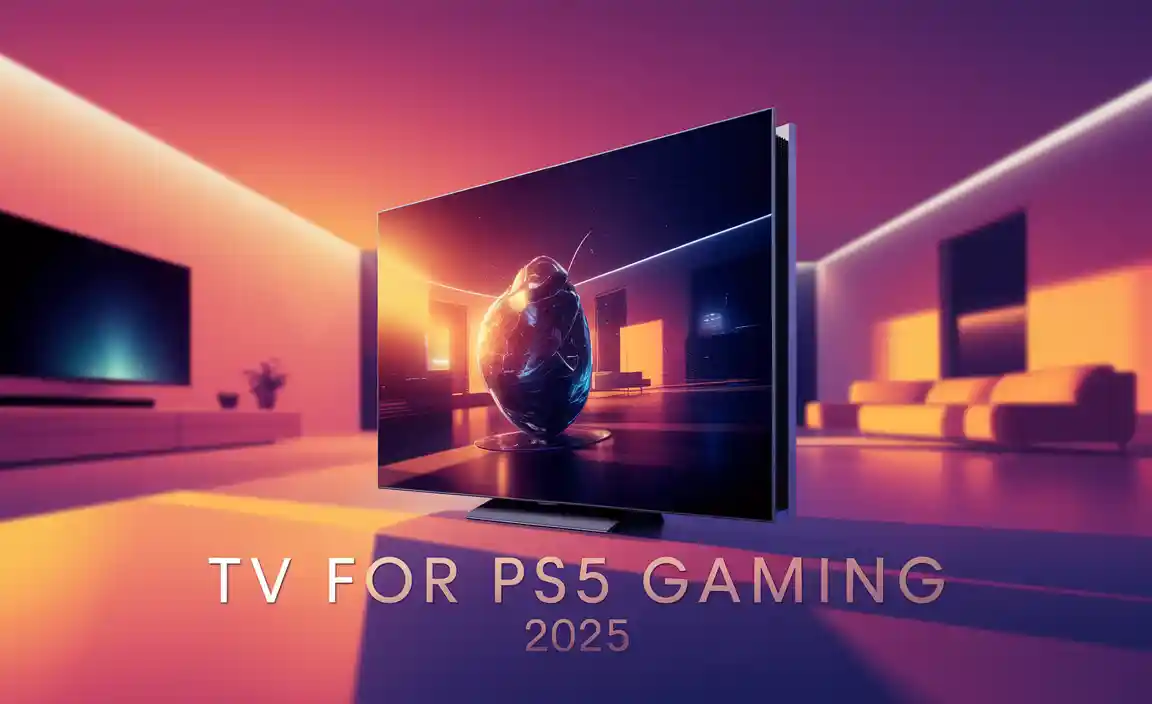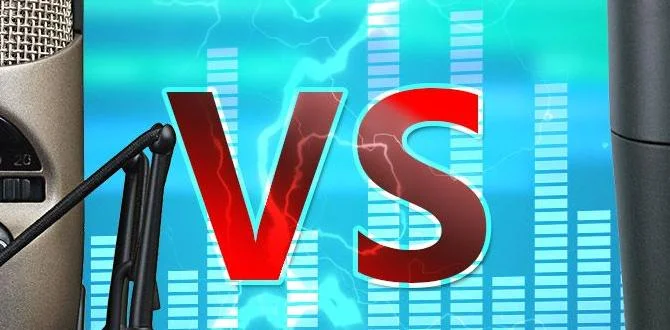Quick Summary
Having trouble distinguishing between Android TV and Google TV? Don’t worry! This guide clears up the confusion with a genius solution to identify and optimize your smart TV experience. We’ll show you how to tell them apart and get the most out of your device.
Hey there, tech fans! Bob E Riley here from Aimguider. Ever feel a little lost when it comes to your smart TV? You’ve got this cool device, but is it “Android TV” or “Google TV”? Sometimes, they seem like the same thing, and honestly, that can be confusing. You just want to kick back and watch something, not decipher tech jargon. Well, you’re in the right place! We’re going to cut through the noise and give you a super simple way to understand the difference. Think of this as your personal guide to making sure your TV is working just right for you. Get ready to feel confident about your smart TV setup!
Android TV vs. Google TV: What’s the Real Difference?
It’s easy to get these two terms mixed up, especially since they’re so closely related. Think of it like this: Android TV is the operating system, the engine under the hood. Google TV is more like a brand-new, snazzy dashboard that uses that engine to give you a more personalized and user-friendly experience. Google TV is actually built on top of Android TV, but it presents everything in a completely different way, focusing heavily on content discovery.
The key takeaway is that while all Google TV devices run on Android TV, not all Android TV devices have the Google TV interface. It’s like having a smartphone (Android TV) and then getting a special app or a redesigned user interface that makes it super easy to find your favorite shows and movies (Google TV).
Why the Confusion? Let’s Break It Down
Google made a big marketing push with “Google TV” to simplify how people find and watch content. They wanted to move away from a purely app-centric view (like on older Android TV versions) to a more curated, recommendation-driven experience. This means that newer TVs from brands like Sony, TCL, and Hisense might come pre-loaded with the Google TV interface, while older models or different brands might stick with the more traditional Android TV interface.
The goal is always to make your viewing experience better. Google TV aims to bring all your streaming services together in one place, suggesting what to watch next based on your viewing habits. Android TV provides the platform for all these apps and services to run, offering a more traditional app-based navigation. So, the “fix” isn’t about fixing something broken; it’s about understanding what you have and how to use it best.
Identifying Your TV: The “Genius Solution”!
The most straightforward way to tell if you have Google TV or classic Android TV is to look at your TV’s home screen. Don’t overthink it; it’s usually quite obvious!
What to Look For on Your Home Screen
- Google TV: If your home screen is organized into rows of content recommendations (like “Movies recommended for you,” “Top picks,” “Shows to continue watching”) pulled from various streaming apps you use, you likely have Google TV. It feels more like a streaming service itself, with prominent recommendations. You’ll also see a “For You” tab at the top.
- Android TV: If your home screen primarily shows a grid of your installed apps (Hulu, Netflix, YouTube, etc.) and you have to open each app to find content, you probably have the classic Android TV interface. There might be a “Recommendations” row, but it’s usually less prominent and less personalized than on Google TV.
Pro Tip: You can also check your TV’s settings. Navigate to “About” or “System Information.” It will often explicitly state “Android TV OS” and then might mention “Google TV” if that interface is active. For example, you might see something like “Android TV OS 10” with a note about the Google TV experience.
Let’s See Some Examples
Imagine you turn on your TV. What pops up?
Scenario 1 (Google TV): You see a vibrant screen with a “For You” tab. Below it are rows like “Action Movies You’ll Love,” “Documentaries to Watch,” followed by “Continue Watching” for Netflix and then “New Season Alert for Stranger Things” from your Netflix app. It feels dynamic and tailored.
Scenario 2 (Android TV): You see a clean layout with rows for “Apps,” “Games,” and “Settings.” Below that, you might have a single row for “Recommended” showing content from a few pre-selected apps. You’ll likely need to click into the Netflix app icon to see what’s new on Netflix.
Leveraging Google TV for a Smarter Entertainment Experience
If you’ve confirmed you have Google TV, congratulations! You’ve got a content discovery powerhouse. The “genius solution” here is to truly embrace its strengths.
Key Features of Google TV to Utilize
- Unified Watchlist: Add any movie or show from any streaming service to a single watchlist. No more trying to remember where you saw that show you wanted to watch!
- Personalized Recommendations: The more you watch, the smarter it gets. Google TV learns your tastes and suggests content you’re likely to enjoy.
- Google Assistant Integration: Use your voice to search for specific shows, actors, genres, or even ask for recommendations (“Hey Google, find me a comedy movie”).
- Live TV Integration: Google TV can integrate with live TV streaming services, bringing live channels into your recommendations.
Making the Most of Your Google TV
- Link Your Streaming Accounts: The first step is to ensure all your streaming service accounts (Netflix, Disney+, Hulu, Prime Video, etc.) are linked within the Google TV settings. This is crucial for recommendations and unified search.
- Use the “For You” Tab: Make this your starting point. Browse the curated rows and see what catches your eye. Don’t be afraid to explore content from services you might not have thought of.
- Build Your Watchlist: Whenever you see something interesting, hit the “Add to Watchlist” button. It’s a lifesaver for staying organized.
- Explore Different Tabs: Besides “For You,” check out the “Movies” and “Shows” tabs for different ways to browse, and the “Live” tab if you use a live TV service.
- Voice Search is Your Friend: Seriously, use it! It’s faster and often more intuitive than typing. Try saying, “Hey Google, show me trailers for new releases.”
Optimizing Your Experience with Classic Android TV
Don’t feel left out if you have classic Android TV. It’s still a powerful platform, and with a few tweaks, you can make it incredibly functional.
Tips for Classic Android TV Users
- App Organization is Key: Since it’s more app-centric, take time to organize your home screen. Pin your most-used apps to the top for quick access.
- Utilize Google Play Store Wisely: Explore the Play Store for customization apps, better media players, or even game launchers.
- Sideloading (Advanced): For the more adventurous, you can explore sideloading apps that aren’t available in the Play Store, although this requires caution. A great resource for understanding Android TV and APKs is Android Police, which often covers these topics.
- Custom Launchers (Advanced): Some users opt for third-party launchers that can change the look and feel of Android TV, offering more customization than the default interface.
The “Fix” for Android TV: Personalization and Efficiency
The “genius solution” for classic Android TV isn’t about getting Google TV; it’s about making the most of the platform you have. This means focusing on:
- Streamlining Your Apps: Uninstall apps you don’t use. Keep your app drawer clean.
- Setting Favorites: Most Android TV interfaces allow you to customize the order of apps on your home screen or pin them. Make sure your top streaming apps are front and center.
- Using the Search Function: While not as integrated as Google TV, the universal search within Android TV can still find content across installed apps.
- Exploring Google Assistant: If your device has Google Assistant, learn its commands for searching content, opening apps, or controlling playback.
Android TV vs. Google TV: Feature Comparison
To solidify the differences, let’s look at a quick comparison. This table highlights what you can expect from each interface.
| Feature | Classic Android TV | Google TV |
|---|---|---|
| Home Screen Focus | App-centric, grid of installed applications. | Content discovery, personalized recommendations across services. |
| Content Aggregation | Primarily relies on individual app content. Might have a basic recommendation row. | Aggregates content from linked streaming services into personalized rows. |
| Watchlist | Generally not a unified feature; managed within individual apps. | Unified watchlist across all linked streaming services. |
| User Interface | More traditional, app-focused interface. | Modern, visually rich interface with prominent content suggestions. |
| Voice Control | Available via Google Assistant, good for app launching and searches. | Deeply integrated with Google Assistant for content discovery and control. |
| Updates | Receives OS updates, but interface may remain similar. | Google regularly updates the Google TV interface with new features and improvements. |
| Availability | Older smart TVs, some newer budget models, and Android TV boxes. | Newer smart TVs from major brands (Sony, TCL, Hisense, etc.). |
What About Upgrading?
Can you upgrade from Android TV to Google TV? Generally, no, not directly. Google TV is a specific interface that manufacturers implement on top of the Android TV operating system. If your TV came with classic Android TV out of the box, it’s unlikely to receive a full Google TV interface update. However, you can get a Google TV experience by purchasing a dedicated streaming device.
Popular Streaming Devices with Google TV:
- Google Chromecast with Google TV: This is the most direct and affordable way to bring the Google TV experience to any TV with an HDMI port. It’s a fantastic solution for older smart TVs or even non-smart TVs. You can find detailed information about its capabilities on Google’s official store page.
- Other Android TV Boxes with Google TV Interface: Some manufacturers produce Android TV boxes that come pre-loaded with the Google TV interface.
This is often the “genius solution” people are looking for if they have an older Android TV and want the newer Google TV features without buying a whole new television. It’s a cost-effective upgrade that breathes new life into older hardware.
Frequently Asked Questions (FAQ)
Q1: Is Google TV better than Android TV?
It depends on your preference! Google TV offers a more modern, content-first experience with excellent universal search and recommendations. Classic Android TV is more flexible for users who prefer directly accessing apps and customizing their interface. For most people seeking simplicity and discovery, Google TV is generally considered an upgrade.
Q2: Can I get Google TV on my old Android TV?
You can’t usually upgrade the built-in interface of an older Android TV to Google TV. However, you can buy a Google Chromecast with Google TV or a similar streaming device. This external device plugs into your TV’s HDMI port, giving you the full Google TV experience on any television.
Q3: Are all smart TVs with Google apps considered Google TV?
No. While Google TV is built on the Android TV operating system and uses Google services, not every TV that runs apps from the Google Play Store is running the Google TV interface. The key is the home screen layout and content discovery features, which are unique to Google TV.
Q4: Will my apps work on both Android TV and Google TV?
Yes, generally. Both platforms run on the Android TV operating system, so most apps available on the Google Play Store for TV will work on both. The way you access and discover those apps might differ, but the app compatibility is usually high.
Q5: How do I update my Android TV or Google TV?
Updates usually happen automatically when your TV is connected to the internet. You can also check manually in your TV’s settings. Go to “Settings” > “System” > “About” > “System Update.” For external devices like Chromecast with Google TV, you’ll find update options within the device’s settings menu.
Q6: What if I can’t find a specific app on my Google TV or Android TV?
First, ensure your TV is connected to the internet. Then, open the Google Play Store app on your TV and search for the app. If it’s not there, it might not be available for Android TV devices. For older Android TV versions, you might be able to sideload an app, but this is for advanced users and not always recommended.
Conclusion
So, there you have it! The “Android TV vs. Google TV fix” isn’t really about a bug or a problem, but about understanding the evolution of your smart TV’s interface. Whether you have the classic Android TV experience or the newer, content-rich Google TV, the key is knowing what you’ve got and how to use it to its full potential. The “genius solution” is truly in the adaptation and optimization. Embrace the curated discovery of Google TV, or master the efficient app management of Android TV. And if you’re craving the Google TV experience on an older set, a simple Chromecast device is your golden ticket.
Whichever platform you’re on, enjoy seamless entertainment. Happy streaming!






